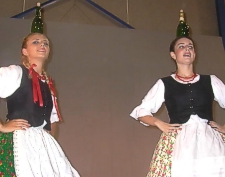 INNIPEG, plopped in the middle of North America, at the juncture of the Red and Assiniboine Rivers, is an eclectic community. This vibrant city teems people whose origins go back to countless countries around the globe. The French inhabit their own enclave in the sister city of St. Boniface, on the western side of the Red River.
INNIPEG, plopped in the middle of North America, at the juncture of the Red and Assiniboine Rivers, is an eclectic community. This vibrant city teems people whose origins go back to countless countries around the globe. The French inhabit their own enclave in the sister city of St. Boniface, on the western side of the Red River. With such a diverse mix totaling 700,000, it’s no wonder that Winnipeg, capital of Manitoba, boasts 130 days of festivals. Imagine, more than a third of the year spent in celebration of ethnic pride.
The mother of all festivals is Folkorama, which has been running every August since 1970. With the participation of 40 countries, it’s reputedly the largest multicultural celebration of its kind in the world.

Bernard, a Metis, making a slingshot
for hunting crows. |
This summer the festival is set for July 31 to August 13. Every neighborhood has two or three pavilions, housed in community centers. Visit a different neighborhood each night and you’ll hit them all in two weeks.
As soon as you enter any pavilion head straight for the food line. The variety of native victuals is mind boggling, not to mention stomach satisfying. Then grab a front row seat for the spectacular stage shows, featuring the music and dance of the many countries around the globe that Winnipeggers hail from.
On my visit I counted 45 pavilions representing as many ethnic groups and countries, including Argentina (with great tango performers), Greece, Korea, Portugal, Romania, Italy, Japan, Slovenia and Africa.

Hungarian bottle dance. |
I enjoyed the Metis, who are of French Canadian stock. They served such unique fare as buffalo burger, stew and bannock, wild rice and rice pudding, washed down with a choice of beer, spirits, coffee or moose milk. (Don’t ask; just try it.)
Annette was pounding dried buffalo meat with the assistance of eight-year-old Ecko. Annette said the dried buffalo meat would last for two years. "It’s the first take-out food."
The performers did the Red River Jig, the national dance of the Metis. At any Metis gathering, there is always a fiddler to entertain. The live exhibits included early family living with demonstrations of sash weaving and grinding pemmican.
The pavilion of Scotland had nonstop Celtic music and dancing from 6 p.m. till midnight. The full marching pipe band was spine tingling.
If you just taste the vast assortment of Scotch, they’ll have to carry you out. They offered such brands as Bowmore, Auchentoshan, Bunnahabhain, Laphroig, Glennfidich Solera and more. Try such tasty fare as Hairy Haggis and Robbie Burns. You can get a full meal or just a pub snack. The menu listed such strange items as Bridie, Scotch Egg, Mealie Jimkes, Fly Cemetery and, well, you get the picture.
The Israel pavilion was set up at the Asper Jewish Community Campus where the internationally renowned Chai Folk Ensemble starred on stage. Their show represents the music harmonies and dance rhythms of Yemen and Morocco as well as Eastern Europe klezmer.
Folklorama tickets come in Family Pack at $33.75 (12 transferable tickets). Single admission is $3.75. More information at www.folkorama.ca or call 1-800-665-0234.
Outstanding accommodations are offered at three high-end hotels: The Inn at the Forks, a beautiful spa hotel; the Fairmont Winnipeg with luxurious rooms, and the elegant chateau style Fort Garry Hotel.